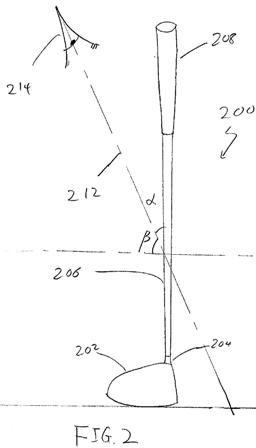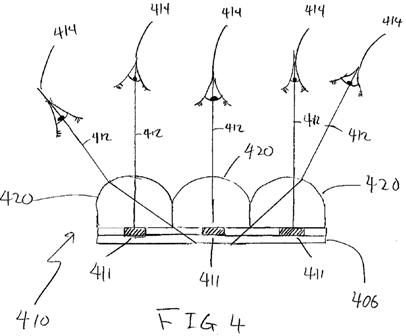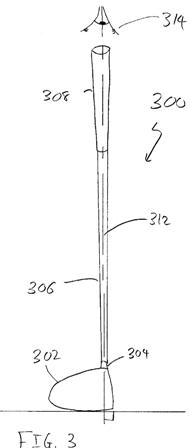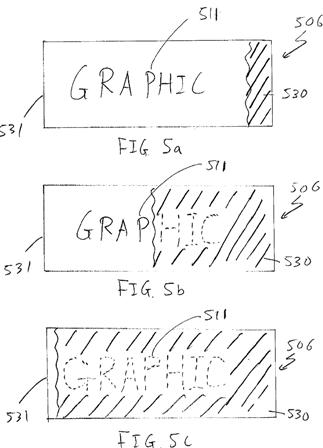Alignments Aides for the Driver!
Well, I am happy to report that some golf equipment manufacturers are looking to take alignment aides beyond the scope of the putter. Just last week Cobra Golf had a patent application publish as US Pub. No. 
[0031] FIG. 1 shows a prospective view of a golf club 100 in accordance with an exemplary embodiment of the present invention. In this exemplary embodiment, it can be seen that the golf club 100 has a head 102 placed at a distal end of the golf club 100 with a hosel extending upwards from the crown of the golf club head 102. Connected to the club head 102 is a shaft 106 stemming from the hosel part of the golf club head 102 with a ferrule 104 placed over the hosel. Finally, a grip 108 connected to a proximal end of the golf club 100 via the shaft 106 opposite of the head 102. It should be noted that in the current exemplary embodiment, the shaft 106 of the current golf club 100 may have a directional based graphic 110 on the shaft itself that can only be seen from a desirable angle wherein the line of vision 112 stemming from the viewer’s eyes 114 is substantially perpendicular to the shaft 106. It may be beneficial to have the directional based graphic 110 only be visible from this desirable angle because a golfer may generally read the directional based graphic 110 on the shaft 106 from a substantially perpendicular orientation.
[0032] Directional based graphic 110 on shafts 106 may be comprised of numerous mixtures of numbers, letters, symbols, decorative patterns, or even logos that add to the aesthetic appeal of the golf club 100. The directional based graphic 110, in order to maximize exposure and readability on a tubular shaped shaft, may generally run horizontally across the length of the shaft 106, making them more susceptible to be viewed from a pair of eyes 114 that are substantially perpendicular to the shaft 106. Although the directional based graphic 110 may serve the important purpose of conveying a message and a visual stimulant to the golfer; these directional based graphic 110 could potentially distract a golfer when the golfer looks down on the shaft 106 while trying to execute a golf shot.
[0033] Because such directional based graphic 110 could be a distraction to the golfer, the directional based graphic 110 in accordance with the current invention may disappear and become invisible once the viewer’s eyes 114 are no longer viewing the directional based graphic 110 from an angle that is substantially perpendicular to the shaft 106. In order to further illustrate the disappearance of the directional based graphic 110, FIG. 2 shows an example of a golf club 200 in accordance with the exemplary embodiment of the present invention wherein the directional based graphic 110 shown in FIG. 1 become invisible when the viewer’s eyes 214 deviate from the substantially perpendicular direction show in FIG. 1. In this current exemplary embodiment shown in FIG. 2, the line of vision 212 from the viewer’s eyes 214 may form an angle .alpha. with the shaft 206, which is not substantially perpendicular to the shaft 206. More specifically, angle .alpha. may be less than about 85 degrees, more preferably less than about 80 degrees, and most preferably less than about 75 degrees. Alternatively speaking, directional based graphic 110 may only be seen when the line of vision is within an angle .beta. of about 20 degrees of being perpendicular to the shaft 206, more preferably within about 10 degrees of being perpendicular to the shaft 206, and most preferably within about 5 degrees of being perpendicular to the shaft 206.[0034] Because the viewer’s eyes 214 are not substantially perpendicular to the shaft 206 in FIG. 2, the directional based graphic 110 that was visible in FIG. 1 from a substantially perpendicular angle is no longer visible, leaving a shaft 206 without any distracting graphic to affect the golfer.
[0035] FIG. 3 shows the golf club 300 in accordance with an exemplary embodiment of the present invention wherein the viewer’s eyes 314 may be looking at the golf club 300 from an address position parallel to and directly down the shaft 306. As it can be seen from FIG. 3, the line of vision 312 being directly parallel to the shaft 306, creates an angle of about 0 degrees between the line of vision 312 and the shaft 306. When the golf club 300 is viewed from the address position, the directional based graphic 110 that were visible in FIG. 1 are no longer visible because the angle formed between the line of vision 312 from the viewer’s eyes 314 and the shaft 306 is about 0 degrees. It may generally be desirable for the shaft directional based graphic 110 to be invisible when the golf club 300 sits in the address position as it minimize the exposure and distraction of the directional based graphic 110 on the golfer.
[0036] In order to achieve the directional based appearance and disappearance of the directional based graphic 110 on the golf club, the directional based graphic 110 may need to be visible in one direction while invisible in another direction. FIG. 4 shows an enlarged view of the shaft 406 of an exemplary embodiment of the present invention wherein the directional based graphic 410 further comprise of a plurality of lenticular lenses 420 and an underlying graphic panel 411. The plurality of lenticular lenses 420 combined with the underlying graphic panel 411 allows for the underlying graphic panel 411 to only be visible from a desirable orientation achieving the desirable results of the directional based graphic 110. More specifically, FIG. 4 shows an enlarged side view of the directional based graphic 410 over the shaft 406 containing a plurality of lenticular lenses that only allows the underlying graphic panel 411 to be visible only from a desirable direction that is substantially perpendicular to the shaft 406.
[0037] Here, the plurality of lenticular lenses 420, due partially to their curved surfaces, only allow the line of sight 412 from the viewer’s eyes 414 to pass directly through the plurality of lenticular lenses 420 and see the underlying graphic panel 411 when it is viewed from a substantially perpendicular orientation. When not viewed from an angle that is substantially perpendicular to the shaft 406, the plurality of lenticular lenses 420 will refract the line of sight 412 from the viewer’s eyes 414 away from the underlying graphic panel 411, preventing the viewer’s eyes to see the underlying graphic panel 411. Utilizing the lenticular lenses 420 on the shaft 406 to cover up the underlying graphic panel 411 will allow the underlying graphic panel 411 in the current exemplary embodiment to be visible only from a desirable orientation that is substantially perpendicular to the shaft 406 while at the same time prevent the underlying graphic panel 411 to be seen when the viewer’s eyes 414 are looking at the shaft 406 from an undesirable angle that is not substantially perpendicular to the shaft 406. More details on the specifics of lenti
cular technology can be found in U.S. Pat. No. 3,538,632 to Anderson titled Lenticular Device and Method for Providing Same, U.S. Pat. No. 3,582,329 to Ivanov et. al. titled Method of Making Lenticular Screens, and U.S. Pat. No. 2,833,176 to Ossoinak titled Arrangement for the Exhibition of Dynamic Scenes to an Observer in Movement With Respect to a Screen; the disclosures of which have been incorporated by reference herein in their entirety.[0038] FIGS. 5a, 5b, and 5c show alternative embodiment of the present invention wherein the directional based graphic 110 may appear and disappear based on the orientation of the shaft 506. More specifically, the directional based graphic 110 portion of the shaft 506 within this alternative embodiment of the present invention may appear and disappear utilizing a shaft 506 having a clear fluid chamber 531 filled with an opaque fluid 530 that may help cover up the underlying graphic panel 511. Opaque fluid 530, as shown in this current exemplary embodiment in FIGS. 5a, 5b, and 5c may generally flow from one side of the clear fluid chamber 531 to another utilizing gravitational forces resulting from the orientation change. In one orientation shown in FIG. 5a, the shaft 506 is oriented in a direction allowing the viewer’s eyes to look at the shaft 506 from a substantially parallel position. In this orientation, the opaque fluid 530 may gather at the shallow end of the clear fluid chamber 531 allowing the underlying graphic panel 511 to show through. In an alternative orientation shown in FIG. 5c, the shaft 506 is oriented in a direction that results from the viewer’s eyes looking at the shaft 506 from another position not substantially parallel to the shaft 506. As FIG. 5c shows, under this orientation, the underlying graphic panel 511 is covered by the opaque fluid 530 making the underlying graphic panel 511 invisible. Finally, in another orientation shown in FIG. 5b, the shaft 506 is in an intermediate transition phase between being substantially parallel to the viewer’s eyes in FIG. 5a and not being substantially parallel to the viewer’s eyes in FIG. 5c. In this intermediate transition phase shown in FIG. 5b, it can be seen that the underlying graphic panel 511 may be partially blocked by the opaque fluid 530 further illustrating the concept behind the appearance and disappearance of the underlying graphic panel 511 under this alternative embodiment of the present invention.
[0039] Turning now to FIG. 5d showing a further alternative embodiment of the present invention wherein the clear fluid chamber 531 is filled with a clear fluid instead of an opaque fluid 530, but utilizes a sleeve 532 that travels in and out of the clear fluid chamber 531 to cover up the underlying graphic panel 511. Under this alternative embodiment, the clear fluid may fill up the entire clear fluid chamber 531 and may generally be clear in color so the underlying graphic panel 511 may still be seen when the sleeve 532 is moved away from the underlying graphic panel 511. The clear fluid may generally be used to guide the movement of the sleeve 532 within the clear fluid chamber 531 of the shaft 506 in accordance with the different orientations of shaft 506. In one orientation, when the shaft 506 is positioned substantially perpendicular to the viewer’s eyes in a horizontal orientation, the gravitational force will generally force the sleeve 532 to move away from the underlying graphic panel 511, making the underling graphic panel 511 visible. Alternatively, in another orientation when the shaft is not positioned substantially perpendicular to the viewer’s eyes but in a vertical orientation, the gravitational force will move the sleeve 532 over the underlying graphic panel 511 concealing the underlying graphic panel 511. It may generally be advantageous to use a sleeve 532 in combination with a clear fluid because this alternative embodiment will allow the entire clear fluid chamber 531 to be filled with a fluid, preventing undesirable sloshing sound that could result from a partially filled clear fluid chamber 531. More details on utilizing a fluid 530 and a sleeve 532 to control the display of the underlying graphic panel 511 may be found in U.S. Pat. No. 2,264,194 to Wuestman titled Advertising Pencil, Pen or the Like and U.S. Pat. No. 4,037,343 to Lonsmin titled Novelty Writing Instrument Having An Appearing And Disappearing Personal Name; the disclosure of both are herein incorporated by reference in their entirety.
[0040] FIG. 6 shows a further alternative embodiment of the present invention wherein the golf club 600 may utilize an accelerometer 650 to determine the orientation of the shaft 606 which in turn determines the visibility of the directional based graphic 610. An accelerometer 650 may generally measure the acceleration that it experiences relative to freefall in order to detect the magnitude and direction of the acceleration as a vector quantity. This vector quantity can be used to sense the orientation, vibration, or even shock of the accelerometer 650 in order to determine the visibility of the directional based graphic 610 under this embodiment. In one embodiment, the accelerometer 650 may be placed within the grip 608 of the golf club 600 because the grip may generally be oriented in the same direction as the shaft 606 to determine the visibility of the directional based graphic 610. More specifically, the accelerometer 650 shown in FIG. 6 within the grip 608 may help sense the orientation of the golf club 600. When the golf club 600 is oriented in a desirable direction, the accelerometer 650 will allow the directional based graphic 610 to be visible. Alternatively, when the golf club 600 is not oriented in a desirable direction, the accelerometer 650 will not allow the directional based graphic 610 to be seen. More specifically, the directional based graphic 610 in this current embodiment may generally be comprised of a polarized material that may change its visibility based on an electrical signal. This electrical signal may be provided by the accelerometer 650, which turns on and off the polarized directional based graphic 610 depending on the orientation of the golf club 600.
[0041] In an alternative embodiment of the present invention, the accelerometer 650 may be placed within the shaft 606 of the golf club 600, as the orientation of the shaft 606 may generally determine whether the directional based graphic 610 should be seen. Finally, in a further alternative embodiment of the present invention, the accelerometer 650 may also be placed within the head 602 of the golf club 100, as certain head orientations will also determine whether the directional based graphic should be visible. It should be noted that the accelerometer 650 shown in FIG. 6 may be placed at either of the above locations, all three of the above locations, or any other location within the golf club 100 so long as it is capable of determining the orientation of the golf club 100 all without departing from the scope and content of the present invention.
[0042] FIG. 7 here shows a further alternative embodiment of the present invention wherein directional based graphic 710 may be applied to the crown 740 portion of the golf club head 702 to help with alignment of the golf club head 702 with an intended path 742. Shown here in FIG. 7, the golf club head 702 is pointed away from the intended path 742 as indicated by the misalignment of the central line 744 of the golf club head 702 with the intended path 742. When the central line 744 of the golf club head 702 is not in alignment with the intended path 742, the directional based graphic 710 may become visible to inform the golfer of the misalignment. Directional based graphic 710, as shown in the current exemplary embodiment may resemble letters, numbers, symbols, arrows, or any other shape capable of indicating misalignment all without departing from the scope and content of the present invention. F
IG. 7 here shows the directional based graphic 710 being visible when the golf club head 702 is shown in an open orientation.[0043] FIG. 8 shows a further alternative embodiment of the present invention wherein the golf club head 802 is in a closed orientation. When golf club head 802 is in a closed position, similar to when a golf club head 802 is in an open position, the central line 844 may generally be misaligned with the intended path 842. When the central line 844 of the golf club head 802 is not in alignment with the intended path 842, the directional based graphic 810 may become visible to inform the golfer of the misalignment. Directional based graphic 810, as shown in the current exemplary embodiment, may resemble letters, numbers, symbols, arrows, or any other shape capable of indicating misalignment all without departing from the scope and content of the present invention.
[0044] Turning now to FIG. 9, wherein golf club head 902 is properly aligned with the intended path 842, causing the directional based graphic 710 and 810 shown in FIGS. 7 and 8 to disappear. When the golf club head 902 is properly aligned, the intended path 842 overlaps the central line 744, leaving the crown of the golf club head 902 free of any markings. It may generally be desirable to have the directional based graphic 710 and 810 invisible when the golf club head 902 is properly aligned to eliminate distractions that could arise from any graphic display.
[0045] In a specific alternative embodiment of the present invention, the directional based graphic 710 and 810 may become invisible by a mere waggling of the golf club 900. More specifically, if a golf club head 902 utilizes graphics that are controlled by a signal producing apparatus such as an accelerometer, such a signal to make the directional based graphics 710 and 810 could be activated by the waggling of the golf club 900 above, causing the directional based graphics 710 and 810 to disappear upon a specific command such as a waggle.
[0046] It should be noted that in FIGS. 7, 8, and 9, the golf club head 702, 802, and 902 may be used to determine the variations in face angle of the golf club head. However, the directional based graphic 710 and 810 display may also be used to determine variations in lie angle or loft angle of the golf club head 702, 802, and 902 utilizing the same directional based graphic 710 and 810 without departing from the scope and content of the present invention. Moreover, although it may be preferable to have the directional based graphic 710 and 810 be invisible when the golf club head 702, 802, and 902 is properly aligned, the directional based graphic 710 and 810 could be visible only when the golf club head 702, 802, and 902 is properly aligned without departing from the scope and content of the present invention.
[0047] FIG. 10 shows a further alternative embodiment of the present invention wherein the directional based graphic 1010 may be used on the hosel 1004 of the golf club to help with the matching and orientating of the hosel 1004 with the various settings generally needed to identify various orientations of an adjustable hosel 1004. More specifically, the directional based graphic 1010 may be used to show certain connection based labels such as being open, closed, or neutral only when the hosel 1004 and the golf club head 1002 combine with each other to generate the appropriate orientation. For example, the directional based graphic 1010 may show an open setting when the hosel 1004 and the golf club head 1002 combine to create a golf club head 1002 that has an open face angle. Alternatively, the directional based graphic 1010 may show a closed setting when the hosel 1004 and the golf club head 1002 combine to create a golf club head 1002 that has a closed face angle.
[0048] FIG. 11 shows a prospective view of a golf club 1100 in accordance with a further alternative embodiment of the present invention at an address position. Golf club 1100 shown in FIG. 11 at an address position allows for a better distinction of the top side 1160 of the shaft 1106 from the bottom side 1162 of the shaft 1106. As it has been shown by the prior figures, it may generally be desirable to only have the directional based graphic 1110 be visible from the bottom side 1162 of the shaft 1106 because it does not create a distraction for the golfer. In this alternative embodiment of the present invention, the golf club is capable of recognizing the orientation of the shaft 1106 relative to the head 1102 via the adjustable hosel 1104 utilizing an accelerometer 1150. Once the orientation of the shaft 1106 relative to the head 1102 is determined, the accelerometer may send an electronic signal to the directional based graphic 1110 to be only visible on the bottom side 1162 of the shaft 1106 while keeping all other directional based graphic 1110 completely invisible. Under this embodiment, the directional based graphic 1110 is determined based purely on the orientation of the shaft 1106 relative to the club head 1102 and stays constantly visible from the bottom side 1162 of the shaft 1106 regardless of the orientation of the actual club.
[0049] Although FIG. 11 shows the golf club 1100 utilizing an accelerometer 1150 at either the grip end of the golf club 1100 or the tip end of the shaft 1106, the accelerometer 1150 could be placed at any location within the golf club 1100 so long as it is capable of determining the relative position of the shaft 1106 with respect to the head 1102 without departing from the scope and content of the present invention. In lieu of utilizing an accelerometer 1150, the golf club 1100 shown in FIG. 11 could use various connection sensors within the adjustable hosel 1104 itself to determine the orientation of the shaft 1106 relative to the head 1102 to achieve the same objective of only activating the directional based graphic 1110 without departing from the scope and content of the present invention. Of course, under this embodiment shown in FIG. 11, the shaft 1106 will have to have a plurality of directional based graphic 1110 around the circumference of the shaft 1106, only to have the appropriate directional based graphic 1110 at the bottom side 1162 of the shaft 1106 activated based on the relative position of the shaft 1106 to the head 1102.
Pretty cool, but just wait for my next post regarding an alignment aid for a golf ball!
Dave Dawsey – Keeping an Eye on Innovative Golf Inventions
PS – check out some interesting golf tee inventions here



